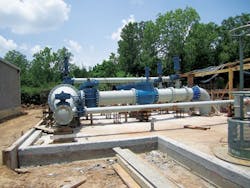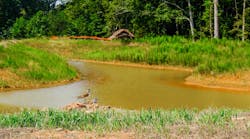Sims Bayou begins near Missouri City, Texas, and meanders northeast until it reaches Buffalo Bayou. As a result of the Federal Flood Damage Reduction Project partnership between the U.S. Army Corps of Engineers and the Harris County Flood Control District, the area recently has undergone significant flood control improvements including widening 19.3 miles of Sims Bayou. Citizens residing in neighborhoods adjacent to Sims Bayou now have a lower risk of flooding than in the past.
The Sims Bayou project was designed and constructed in an environmentally responsible manner and an increasing number of birds and wildlife already can be seen along completed segments and at the storm water detention basins.
An Uphill Climb
As part of the project, a new sanitary sewer lift station with a current capacity of 33.12 million gal per day (mgd) and ultimate capacity of 42 mgd was built for the city of Houston, a project that was not without its challenges.
The large variation in influent flow rate requires pumps be sized to accommodate an average dry weather flow of 3.08 mgd, an average wet weather flow of 7.6 mgd and a peak two-hour flow rate of 41.5 mgd. A single pump must accommodate the average dry weather flow and the combined pumps must accommodate the 41.5 mgd, a flow variation that represents a peaking factor of 13.5. The pumps, individually and collectively, must meet the design flow range at the specified dynamic head and with the required net positive suction head.
A second issue was that the existing force main limited the flow capacity of the lift station to 33.12 mgd. Once a new parallel force main is constructed, the lift station will be able to pump its design rate of 42 mgd.
Finally, the city of Houston preferred to build a “Station in the Round,” as opposed to a rectangular pump station, due to the lower construction cost of building the 46-ft-deep well. The consultant proposed a 42-ft-diameter wet well to accommodate six 10,000-gal-per-minute pumps. During dry weather, the station alternates the pumps to distribute wear evenly over the six pumps. During a wet weather event, the combined pumps can accommodate a large range of flows, including the two-hour peak flow.
Working Together
The project was bid with an item for the pump manufacturer to conduct computational fluid dynamics (CFD) studies, which analyze potential fluid flow problems prior to pump delivery. The CFD studies evaluated the proposed design of the wet well and its ability to provide effective and acceptable hydraulic conditions for the pumps. Xylem’s CFD study revealed problems with flow distribution at the approach to the pumps. Because of poor approach conditions to the wet well, several pumps would suffer from excessive swirl and uneven velocity distribution at the impeller eye.
What followed was a conference call between the project manager, the consulting engineer, and Hahn Equipment, a Xylem distributor, to discuss the problems. Suggested modifications to the pumps recommended by Hahn—six Flygt CP3356 280-hp submersible pumps—included enlarged inlet ports, guide vanes inside the ports and guide vanes inside the inlet chamber. These changes would improve the hydraulic conditions for the selected pumps. This is only one example of how stakeholders working closely together were able to avoid costly future modifications to this project.
Technology Selection
The six pumps won in a competitive public bid against a comparable equipment manufacturer. The pumps can easily be upgraded should a second phase of construction be required.
The submersible pumps do not require special housings or a superstructure to support them, a design feature that reduces construction costs, too. The pumps are smaller than non-submersible counterparts because the motor and hydraulics are integrated into one compact unit, resulting in smaller pumping stations that are less complex to build. Finally, the pumps take up less space when they are submerged during operation, and noise and cooling problems are virtually eliminated.
Hahn was still not done working on behalf of the city and the consulting engineer. The distributor recommended any pumps being considered for the project be subjected to a test at the manufacturer’s facility. The results of this test confirmed the design points and net positive suction head available for each pump. In addition, the specifications required the contractor to select a pump manufacturer that could handle the responsibility for the full system, including testing in the U.S.
In the end, the city of Houston, Klotz Associates and Hahn Equipment worked arm-in-arm to deliver a successful pump station to the Sims Bayou Federal Flood Reduction Project in Texas.
Download: Here






